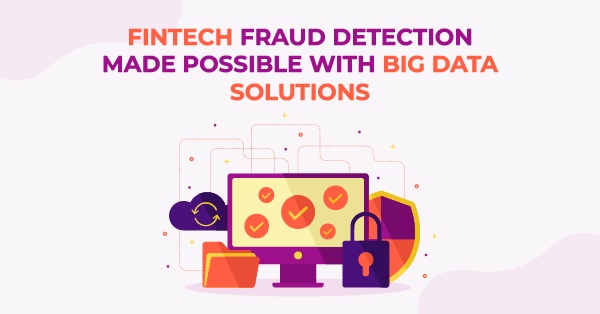The financial services sector has long faced constant danger from financial fraud. Fraud detection and prevention strategies must be comprehensive because the issue is rapidly evolving. Fintech solutions can now use Big Data to identify and stop fraudulent activity thanks to advancements in Big Data technologies. To reduce danger for institutions, financial fraud detection is crucial.
Fraudsters can quickly drain individual accounts, and credit cards can easily accumulate a thousand dollars in charges. Even worse, organized crime groups can pull off complex scams and steal millions of dollars. In this post, we will discuss how Big Data can help in Fintech Fraud detection and prevention -
Why Big Data is an Effective Fraud Detection and Prevention Tool in Fintech?
Since financial fraud can result in substantial economic losses and harm the institution's reputation, it poses a severe problem for financial institutions. Fraudsters use a variety of strategies, such as identity theft, account takeover, and money laundering, to defraud financial organizations.
Accuracy of Fraud Prevention:
Without data mining, suspicious significant transactions or blatant fraud can be found. The provider can freeze that account, for instance, if a customer uses their credit card at one store and then looks to use it at another store across the country an hour later. However, data mining enables highly accurate detection of more covert fraud indications.
Before a customer realizes their card or account has been compromised, fraud can be detected by using customer information to forecast general patterns and identify suspicious transactions. Fewer transactions are marked as fraudulent, thanks to technological advancements and machine learning techniques.
More than ever, consumers use a variety of accounts, travel, and make transactions online. Consumers can handle their finances on the go thanks to mobile apps, while fintech solutions can preserve accurate data thanks to the Big Data technology.
Artificial Intelligence:
Machine learning, a subset of Artificial Intelligence that can recognize previously taught patterns and look for them in datasets, and data mining go hand in hand. It has taken years for Machine Learning to advance to the point where it can manage intricate consumer patterns and data.
Big Data fraud prevention techniques previously unattainable by financial organizations are now possible, thanks to the convergence of Big Data solutions and Artificial Intelligence. Machine learning comes in various shapes and sizes, with varying degrees of learning potential. The labelled data used in supervised learning originates from historical datasets with known results, such as fraudulent or legitimate past transactions.
Unsupervised learning uses unlabeled data with unknown effects but still can make inferences and spot trends. Finally, a novel, cutting-edge technique called semi-supervised learning combines the two approaches. Artificial Intelligence requires all three kinds of learning and must be continually improved with new software and procedures.
Fighting Fraudulent Accounts:
Banks work to reduce new account usage restrictions and make opening new accounts as simple as possible for new clients. This, however, also creates opportunities for fraud, mainly if con artists use fictitious identities to establish the charges. The bank is aware of stolen social security numbers and false identification documents.
In instances of bank fraud, fraudulent account takeovers are another problem. These takeovers happen when a fraudster uses stolen customer data and a few minor adjustments to contact information to get control of an existing account. Fighting these accounts is more crucial than ever because data breaches are still common and can reveal the account information of millions of consumers.
Big Data along with data mining and machine learning systems have a keen eye for fraud detection. They also have the ability to process enormous quantities of data that are needed to identify transactions from fake or compromised accounts. Whether the source of the fraud was a phishing email or a stolen credit card, financial organizations must make significant investments in detecting financial fraud.
Preventing Credit Card Fraud:
Criminals can easily steal and use credit card information to make unauthorized transactions. Although customers can manually freeze their accounts and financial institutions occasionally reissue credit cards, these measures are rarely sufficient to stop fraud. When account holders declare an income level higher than what they earn, they can open a more extensive line of credit than they are entitled to, another possible source of credit card fraud.
Financial institutions must proactively check all accounts for indications of deception because this occurs with new and existing clients. Companies can use data mining to compare client behavior with similar competitors and get precise financial fraud detection alerts. For example, even though each customer has a different spending style, there are significant patterns in each transaction's mode, method, and dollar amount.
For the card provider to stop the trade and get in touch with the client for follow-up, fraud analysis programs must be able to identify fraudulent transactions in a matter of seconds. Although it takes a lot of computing capacity, this is an essential investment for loss prevention and the customer experience which is made possible by Big Data solutions.
Detecting Insurance Fraud:
Medical, car, and property insurance policies can all be manipulated for financial gain. Insurance fraud includes all of these. Insurance-related financial organizations must proactively implement new systems to catch this fraud. Two examples are inflated claims or lying about the source of harm in property insurance claims. Big Data mining and AI can detect insurance fraud, just like with other kinds of fraud.
How Big Data Work Towards Fraud Detection and Prevention?
Big Data technologies can help financial institutions overcome the challenges associated with fraud detection and prevention. Big Data can analyze vast amounts of data from various sources in real time and identify fraudulent activities accurately.
Advanced Analytics:
Big Data technologies can help financial institutions leverage advanced analytics techniques such as Machine Learning, Artificial Intelligence, Deep Learning, and Predictive Modeling to identify fraudulent activities. These techniques can analyze vast amounts of data and identify patterns that indicate fraudulent activities.
Real-Time Monitoring:
Big Data can monitor transactions across fintech solutions in real-time and flag any suspicious activities immediately. Real-time monitoring enables financial institutions to respond quickly to fraud attempts, preventing financial losses and minimizing customer impact.
Data Integration:
Big Data technologies can integrate data from various sources, including internal and external sources, to identify fraudulent activities. Data integration enables financial institutions to analyze all relevant data and gain a comprehensive view of customer behavior, making identifying and preventing fraud easier.
Fraud Visualization:
Big Data can provide interactive visualizations of fraudulent activities, making it easier for fraud analysts to identify patterns and trends. Fraud visualization enables financial institutions to detect fraudulent activities quickly and take appropriate actions to prevent further fraud.
Risk Assessment:
Big Data solutions can help financial institutions assess the risk associated with financial transactions and customers. Risk assessment enables financial institutions to identify high-risk transactions and customers and act appropriately to prevent fraud.
The Final Lines
Fraud detection and prevention are critical for the financial services industry, and Big Data can help financial institutions overcome the associated challenges. Big Data technologies can analyze vast amounts of data, identify real-time fraudulent activities, and provide insights to prevent future fraud attempts. As a result, with the right Big Data solutions in place, financial institutions can improve their fraud prevention capabilities, enhance customer experience, and maintain compliance with regulatory requirements.


No comments yet